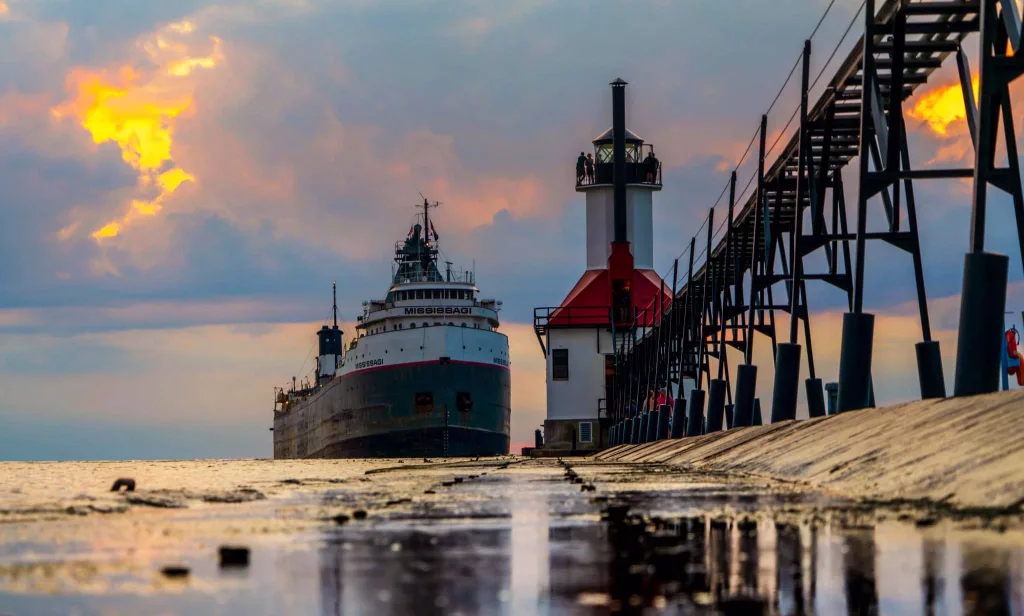The freighter in the St. Joseph River channel earlier this week will be the last one you see in the local harbor until the spring, as word comes from the U.S. Army Corps of Engineers that the Soo Locks in Sault Ste. Marie will close to marine traffic beginning 11:59 pm tomorrow, January 15th through 12:01 am on March 25th to perform critical maintenance.
The functioning commercial harbor at St. Joseph and Benton Harbor sees considerable traffic from ships hauling various commodities from road building materials to salt, gravel and other items.
More than 4,500 vessels, carrying up to 80 million tons of cargo, maneuver through the locks annually bound for ports throughout the Great Lakes. Iron ore, coal, wheat and limestone are among the most frequently carried commodities. Opened in 1969, the Poe Lock is 1,200 feet long. The MacArthur Lock was opened in 1943 and is 800 feet long.
The operating season is fixed by federal regulation and is driven in part by the feasibility of vessels operating in typical ice conditions.
Every year, the Corps uses the winter period to perform maintenance to keep the Soo Locks operating. The Soo Area Office team works long hours in extreme conditions to complete a significant amount of maintenance during this annual closure period. The work they perform is unique, especially given the harsh northern Michigan conditions they work in.
Soo Area Office Area Engineer Kevin Sprague says, “It is a difficult time in terms of weather to complete this work, but it keeps this important national infrastructure project operating during shipping season,”
The Corps of Engineers has several projects to complete before reopening the locks in March.
Sprague tells us, “The first step is to place the bulkheads then our dive team goes into the freezing water to seal the bulkheads and prepare the locks for dewatering.” He adds, “Most of the maintenance projects will take place on the dewatered Poe Lock, the only lock large enough for the 1,000-foot freighters to transit.”
The team will install temporary panel bridges across the MacArthur and Poe Locks. Those panel bridges will provide the ability to mobilize materials and equipment to the job sites throughout the winter closure.
Maintenance crews will complete Poe Lock upstream and downstream miter gate structural repair work. The miter gates are the large gates that serve as dams at each end of the lock chamber allowing the water to be raised and lowered in the chamber. One of the intermediate miter gate concrete sills will get major repairs as well.
Crews will replace ice flushing valves on the upstream miter gates and make repairs to one of the lock filling valves and one of the lock emptying valves.
Crews will also clean the Poe Lock underfloor drainage system. That is important to ensure the lock can be effectively dewatered in the future and goes a long way to minimizing ice buildup on the lock floor while work is being done.
The U.S. Army Corps of Engineers will drydock its barge Huron on the Poe Lock floor where crews will inspect, repair, sand blast and paint it. That is a cost-effective way for the Corps to maintain its barge.
In addition to all of that, crews also perform a wide range of other maintenance tasks from fender timber replacements on the piers to inspections and preventative maintenance on electrical and mechanical systems on both Poe and MacArthur Locks.
Interested individuals can watch the Detroit District Facebook page at https://www.facebook.com/USACEDetroitDistrict for information about the last vessel to transit the Poe Locks for the 2020-2021 shipping season and updates about the maintenance work.
The Corps is building a second Poe-sized lock to provide much needed resiliency in the Great Lakes Navigation System. The second Poe-size lock, 110-feet by 1,200-feet, is being built on the existing Davis and Sabin Locks sites. The Davis Lock opened in 1914, not used since 2018, and only to transport Corps vessels. The Sabin Lock opened in 1918, has been inactive since 1989. Both the Sabin and Davis Locks are too shallow for most modern vessels.
The Corps’ contractor wrapped up the first year of upstream channel deepening mid-December, excavating between two and six feet of Jacobsville sandstone to deepen the north canal enough for the 1,000-foot ships that will use it. The deepening work will resume in April 2021. The project’s second phase to stabilize the existing upstream approach walls will also begin in April.
The project’s final phase is construction of the new lock chamber. The Detroit District is preparing the 100-percent design package and the final design review will be in early 2021. Corps officials anticipate phase three construction will begin in spring of 2022.
The U.S. Army Corps of Engineers, Detroit District, maintains a navigation system of 95 harbors, including the Great Lakes Connecting Channels that join lakes Superior, Michigan, Huron, St. Clair and Erie.
The file photo of a freighter alongside the North Pier at St. Joseph accompanying this story on Moody on the Market is courtesy of award winning professional photographer Molly Pate of Berrien Springs.






